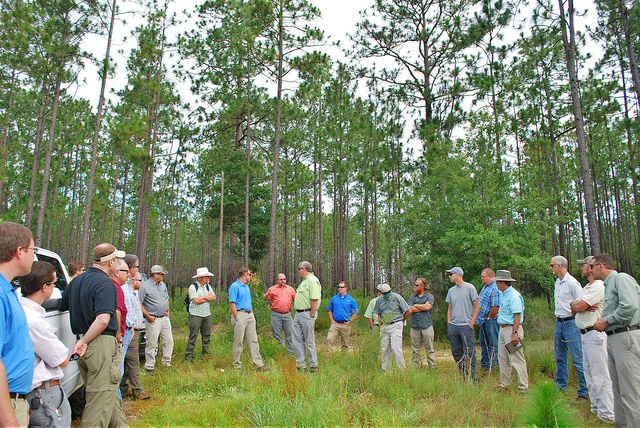
In response to a 2014 Farm Bill provision, the U.S. Department of Agriculture (USDA) has been attempting to demonstrate the power of well-designed public-private partnerships to maximize the impact of federal conservation programs. Since the Regional Conservation Partnership Program (RCPP) began in 2014, USDA partners have invested over $2 billion in conservation projects across the country. For the latest round of RCPP funding, USDA Secretary Tom Vilsack announced that the Department will invest $225 million in 88 conservation projects for fiscal year (FY) 2017. The federal investment will leverage an additional $500 million from a variety of local partners, including state agencies and non-governmental organizations.
RCPP, which is administered by USDA’s Natural Resources Conservation Service (NRCS), is unique among farm bill conservation programs because farmers and ranchers do not apply directly to the program for funding. Instead, partner entities (generally, non-profit groups, conservation districts, or other state or local agencies) design and submit project proposals. Once approved by NRCS, farmers and ranchers can then apply to participate in the projects. NRCS and its partner groups provide financial and technical assistance to farmers to implement conservation activities to help tackle priority natural resource concerns in a given project area.
2017 RCPP Overview
As in previous years, interest in conservation partnerships was very high during the FY 2017 application cycle. According to USDA’s press release, more than one half of all FY 2017 projects will focus on water quality, water quantity, or both. Over one quarter of the projects focus on enhancing fish and wildlife habitat, while the remaining 25 percent focus on soil health and other resource concerns.
Roughly 32 percent of the projects were chosen at the state-level; NRCS national headquarters selected 50 percent; and 18 percent of the projects target Critical Conservation Areas.
The NRCS website hosts a map of projects, full list of project descriptions, and a Q&A page.
Project Profiles
The National Sustainable Agriculture Coalition (NSAC) helped create RCPP in the 2014 Farm Bill, and we are thrilled to report that three NSAC member organizations will be partners on RCPP projects in FY 2017.
- In Illinois, NSAC member group Illinois Stewardship Alliance will work with farmers, NRCS, and 11 other partners to advance Illinois’ Nutrient Loss Reduction Strategy. Illinois contributes 20 percent of the nitrogen and 11 percent of the phosphorus, yet only 7 percent of the water to the Gulf of Mexico through the Mississippi River. The project, lead by American Farmland Trust, will focus on breaking down barriers to conservation practice adoption in one of the three highest phosphorous-yielding watersheds in the state.
- In Maryland, Future Harvest – Chesapeake Alliance for Sustainable Agriculture will work with NRCS, lead partner Chesapeake Bay Foundation, and five other partners to support roughly 20 livestock farmers in Maryland as they convert cropland to pasture and transition existing pasture-based operations to more management intensive grazing systems. At the same time, partners will capitalize on opportunities to implement related practices such as stream livestock exclusion and forested buffers. Finally, the partnership will expand efforts to provide permanent easements on Conservation Reserve Enhancement Program forested buffers as a model for future efforts.
- In Pennsylvania, the Pennsylvania Association for Sustainable Agriculture will work with NRCS, lead partner Chesapeake Bay Foundation, and six additional partners to build farmer management capacity to implement strategic farm conservation practices that promote soil health (i.e., maximize in soil organic matter, soil organisms, and nutrients) and improve “whole-farm” conservation performance. While addressing other resource concerns of the participating farms, the partners will focus on implementing high-level, innovative conservation stewardship practices on 1,000 acres annually for three years.
Impacts of Appropriations Decisions
The bulk of RCPP’s funding comes from the Environmental Quality Incentives Program (EQIP), Conservation Stewardship Program (CSP), Agricultural Conservation Easement Program (ACEP), and Healthy Forests Reserve Program (HFRP) – each of which contributes up to 7 percent of their baseline funding.
This funding structure means that any cuts to the underlying programs translate into cuts for RCPP. Although the programs are technically under the jurisdiction of the House and Senate Agriculture Committees, appropriators often use a budget gimmick known as “changes in mandatory program spending” (also known as CHIMPS) to raid farm bill conservation dollars each year.
For FY 2017, both the House Agriculture Appropriations bill and the Senate Agriculture Appropriations bill include cuts to these farm bill conservation programs. The Senate bill cuts farm bill funding for EQIP by 12 percent ($191 million), while the House bill cuts CSP by 20 percent (2 million acres) and EQIP by 13 percent ($211 million). Additionally, automatic annual cuts known as sequestration will cut RCPP, EQIP, CSP, ACEP and HFRP funding by roughly 7 percent, on top of any cuts made through the appropriations process.
Fortunately, there is still time to persuade Congress not to cut conservation program funding in FY 2017. Later this spring, the House and Senate will need to hash out the differences between their two appropriations bills in order to pass final funding legislation for the remainder of the fiscal year. As they do so, NSAC and our allies will vigorously oppose any effort to use CHIMPS to reduce farm bill conservation program funding.
Visit our blog to get the latest update on the FY 2017 appropriations process and our previous coverage of the House and Senate bills. You can also download our full appropriations chart here.

